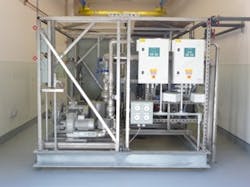Washington State Parks Does Its Part
The environmental health conditions of Puget Sound and Hood Canal in Washington state are being impacted negatively by regional development pressures. Negative impacts encountered in sound and canal waters include low dissolved oxygen levels, shellfish bed closures, presence of toxic waste sites and increased storm water runoff from paved surfaces.
Washington state’s response is the Puget Sound Initiative, an action plan to protect and restore the environmental health of Puget Sound and Hood Canal. A major component of this action plan is to decrease pollution being discharged into Puget Sound and Hood Canal from a variety of sources, including failing septic drain fields and wastewater treatment systems.
Washington State Parks and Recreation Commission (Parks) received funding through this initiative to employ innovative solutions in addressing wastewater system issues at a number of parks with waterfront on either Puget Sound or Hood Canal. Five of these parks—Fort Flagler, Larrabee, Fay Bainbridge, Illahee and Kitsap Memorial State parks—used septic systems and drain fields or lagoons. The wastewater at the parks includes RV waste, which results in higher-than-normal influent loadings, especially nitrogen.
Parks decided to employ membrane bioreactor (MBR) technology, in part to increase the level of wastewater treatment for the selected parks. MBRs also were selected for their ability to minimize site footprint requirements on park property and provide the capability for remote facility operations, nutrient removal and the opportunity for reuse of the effluent.
With the assistance of a procurement engineer, Parks created an invitation for bids to select a single supplier to provide an MBR system for each of the five parks and potentially for other state parks in the future. The Enviroquip MBR System was selected based on lowest capital cost, lowest operation and maintenance costs, and lowest cost of ownership. The equipment used for all the projects was standardized with the same type, and in many cases, the same model.
The Fort Flagler plant has been in operation since June 2009. Parks chose to contract outside operations staff to operate the plant rather than train its own staff. Parks is also planning to use the same operations staff group to operate its other facilities as they come online. Some concerns during design were high flows over holiday weekends and plant operation during the off-season, when flows at the plant can vary by 90%. The flexibility integrated into the design has allowed the operator to come up with strategies to maintain effluent quality during periods of low flow, which was an initial challenge for plant operations. One of the strategies it uses is remotely turning equipment on or off to provide nutrients for the biology of the plant when it receives very little flow during the winter.
The Larrabee State Park plant started up in November 2009. Pollutants entering the Puget Sound and Hood Canal from these two parks have been reduced by more than 95%. The third Parks MBR project is due to start up in January 2011.
